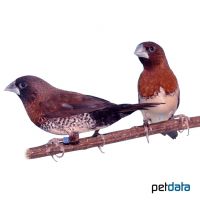Chestnut-breasted Munia (Lonchura castaneothorax)
| Chestnut-breasted Munia Lonchura castaneothorax | |
|---|---|
| Name | Chestnut-breasted Munia |
| Name Lat. | Lonchura castaneothorax |
| Family | Estrildid Finches |
| Family lat. | Estrildidae |
| Order | Perching Birds |
| Order lat. | Passeriformes |
| Origin | Australia |
| Climate | Tropical |
| Diet | Estrilded Finch seed, sprouts, veggies |
| Keeping | Pair, group |
| Care Level | Easy |
| Reproduction | Finch nest |
| Life Span | 5-10 years |
| Protection | No |
| Metric Units | |
| Size | 11 cm |
| Temperature | Room temperature |
| Housing | 80 x 40 x 40 cm |
| US Units | |
| Size | 4.3" |
| Temperature | Room temperature |
| Housing | 30" x 15" x 15" |
Distribution and habitat
The home of the Brown-breasted Reed Finches is in northern and eastern Australia, as well as New Guinea and New Caledonia. They live in extensive marshes with grass and reeds, near rivers and as crop followers in artificially irrigated areas. Since the export ban in 1960, they are only available as a breeding form in several color mutations.
Cage size
The minimum cage size is 80 x 40 x 40 cm (L x W x H) for a pair. The cage size must not be undercut even in case of justified single keeping. For another 2-3 birds, species compatibility provided, the floor space must be increased by 25%. The cage must be placed in a bright, draught-free and quiet place at a height of at least 80 cm (except aviaries), have a rectangular base and be opaque on three sides, aviaries on one side. Keeping in an aviary is preferable.
Maintenance
The floor must be covered with sand, wood granulate, bark mulch or similar material and must be cleaned regularly. At least 3 perches made of wood or branches of varying thickness and height must be installed in such a way that they can only be reached by flying and that the longest possible flight distance is created. They need a bathing opportunity as well as biotope-like hiding, sleeping and nesting possibilities. It is recommended to provide them with grasses, reeds and bushes. The room temperature should not fall below 15 °C.
Diet
The species-specific feed offer consists of mixed seeds, available in specialized trade as "Exotenfutter" in premium quality, supplemented with foxtail millet, hulled oats, green panicle millet, germinated seeds (millet, wheat), green fodder (chickweed), knotted grass seeds, cucumber slices and, especially for rearing young, egg fodder mixed with germinal fodder, as well as small quantities of insects and insect larvae (small, skinned, cut-up mealybug larvae, ant pupae, pinkies). Charcoal, vitamine lime and shell grit are needed as digestive aids. Drinking water must always be available in birdbaths or stable, open containers and, like food, must be offered fresh daily in clean containers.
A varied diet promotes health and prevents deficiency symptoms.
Reproduction and breeding
Both sexes are equally colored, the females are usually duller and the breast band may be narrower, the males are almost only recognizable by their song.
They like to breed in biotope-like facilities such as basket nests (bionesters) and semi-open nest boxes of medium size, or freely in branches (e.g. broom, bamboo, reeds, etc.). Nesting material consists of coconut fibers, sisal, broad longer grasses, and grass fibers for padding. The clutch consists of 3-7 eggs, the incubation period is 13-15 days. The breeding season is, biologically speaking, all year round. When breeding, the room temperature should be at least 18 ° C.
Important
The birds may only be kept in pairs or groups
They must not be kept in a round cage. For flock keeping, an aviary is required. For outdoor aviary keeping, they also require a heated shelter of at least 1 m² floor area and 1.70 m height, which can be visited by the birds at any time. The temperature in the shelter must not fall below 15 °C and the furnishings must correspond to those of cage keeping
Sufficient daylight or flicker-free artificial light (stroboscopic effect) corresponding to the light spectrum of natural sunlight must be provided in rooms, including shelters. The lighting duration must be between 8 and 14 hours per day. The day-night rhythm must be observed. An adequate indoor climate must be provided. The health condition of the birds must be checked daily.
Further literature can be found in your pet store.
References
Text: Othmar Sieberer; Image: petdata
Source: BMELV (1995): Tierschutzgutachten - Mindestanforderungen an die Haltung von Kleinvögeln; BIELFELD (1996): Das Prachtfinken-Buch, Verlag Eugen Ulmer; GRUMMT & STREHLOW (2009): Zootierhaltung - Tiere in menschlicher Obhut: Vögel, Verlag Harri Deutsch
- Gemäß § 21 Abs. 5 Tierschutzgesetz idgF
